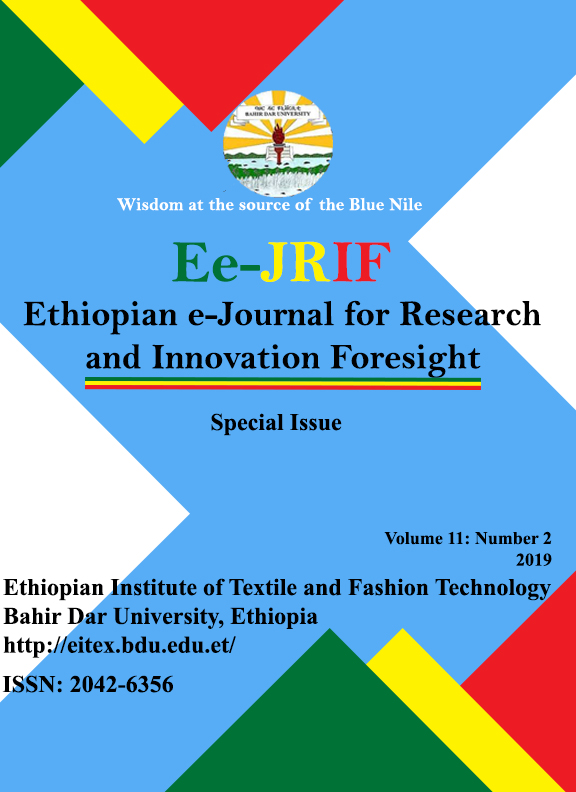Comparative Evaluation Of Dry Brewer Grain, Palm Kernel Cake, And Wheat Offal With Conventional Additives, Sucrose And Maize, In The Ensiling Process Using Water Hyacinth As Forage
Abstract
Silage additives are natural or industrial products that are often added to forages to improve or alter fermentation, reduce fermentation losses, promote the growth of lactic acid bacteria and improve the stability of the silage. Concern in added cost as a result of conventional additives in the ensiling process has necessitated a need for alternative cheap sources. .Hence, three relatively cheap and readily available agro-industrial additives, wheat offal (WO), brewer dry grain (BDG) and palm kernel cake (PKC) were tested with two conventional additives, sucrose (S) and cracked maize grains (CM), for their ability to properly ferment and impart high nutritional qualities to ensiled water hyacinth (WH). Thus WH, a prolific plant with a high biomass yield was ensiled with each of the named additive in turn. From these, the following treatment silages were prepared: WHS, WHCM, WHWO, WHBDG and WHPKC. After 42 days ensiling period, quality and chemical composition were assessed. Results indicated positive physical attributes in colour, texture and odour in all experimental silages. Crude protein for WHBDG (23.25 %) and WHPKC (20.10 %) were higher (p < 0.05) than those of WHS, WHCM and WHWO. For the fibre detergent fractions, the NDF, ADF and ADL followed similar trend. The dry matter (%) of the silages ranged from 11.34 (WHS) to 22.39 (WHBDG). The pH and temperature (˚Ϲ) were not significantly different (p > 0.05) ranging respectively from 2.8 to 3.45 and 27.5 to 28.5. Findings indicated that all tested additives compared favourably with the controls; WO performed best; BDG and PKC performed no less than the conventional S and CM additives. This observation is suggestive that WO, BDG and PKC can replace the conventional additives, sucrose and cracked maize in an ensiling process.References
Abegunde, T.O., Akinropo, T.F., Akande T.O. and Ogunyemi, E.K. (2017).Proximate composition and physic-chemical parameters of water hyacinth (Eicchornia crassipes) ensiled with breadfruit (Artocarpus altilis) as feed for WAD goats, Nigerian Journal of Animal Production, 44 (5): 194-198.
Ibhaze, G.A, Alade, C.T., Fajemisin,A.N., Olorunisomo, O.A., Adewunmi, M.K., Ekeocha, A.H. and Tona, G.O. (2015).Quality and preference of Gmelina arbore leaves and cassava peel silage as off season feed for West African Dwarf goats, Proceedings of 20th Annual Conference of Animal Science Association of Nigeria, 6-10 September, 2015, University of Ibadan, p.688-692.
Akinwande, V.O. (2011).Utilisation of Ensiled Water Hyacinth Eicchornia crassipes by West African Dwarf Sheep, Ph.D Thesis, University of Ibadan.
Ijebu-Ode in Maps (1990). A Publication of the Department of Geography, Ogun State College of Education, Ijebu-Ode, Nigeria.
Babayemi, O.J., (2009). Silage quality, dry matter intake and digestibility by West African dwarf sheep of Guinea grass (Panicum maximum cv Ntchisi) harvested at 4 and 12 week regrowths, African Journal of Biotechnology, 8 (16): 3983-3988.
AOAC (1995): Official Methods of Analysis, 16th ed., Association of Official Analytical Chemists, Arlington, V.A, p.69-88.
Van Soest, P.J., Robertson, J.B. and Lewis, B.A.(1991): Methods for dietary fibre, neutral detergent fibre, and non starch polysaccharides in relation to animal nutrition, Journal of Dairy Science, 74: 3583-3597.
SAS (2003): Statistical Analytical Systems, user’s guide, version 8 ed, SAS Institute, Carry, North Carolina, USA.
Duncan, D.B. (1955): Multiple Range and Multiple F Tests, Biometrics, 11: 1-42.
McDonald, P., Edwards, R.A. and Greenhalgh, J.F.D. (1988): Animal Nutrition, 4th Ed, Essex, U.K., Longman Publishers, 479 p.
Menesis M.D., Megias J, Madrid A, Martinez-Teruel F, Hernandez J, Oliva J (2007). Evaluation of the phytosanitary, fermentative and nutritive characteristics of the silage made from crude artichoke (Chynara scolymus, L.) by-product feeding for ruminants. Small Ruminant Research. 70: 292-296.
Baba, M., Nasir, A., Kabiru, A., Erakpotobor,M. and Umar, G.A. (2018): Effects of additives and their levels of inclusion on nutritive value of silage made from elephant grass (Pennisetum purpureum), Nigerian Journal of Animal Production, 45 (2): 352-362.
Wasaya, A., Shahzad, G. and Rehman, H. (2008). Silage making – a quality forage preservation practice. Retrieved from http://DAWN.com
Copyright (c) 2020 Akinwande Victor Olusegun, Mako A. Adejoke

This work is licensed under a Creative Commons Attribution-NonCommercial 4.0 International License.

